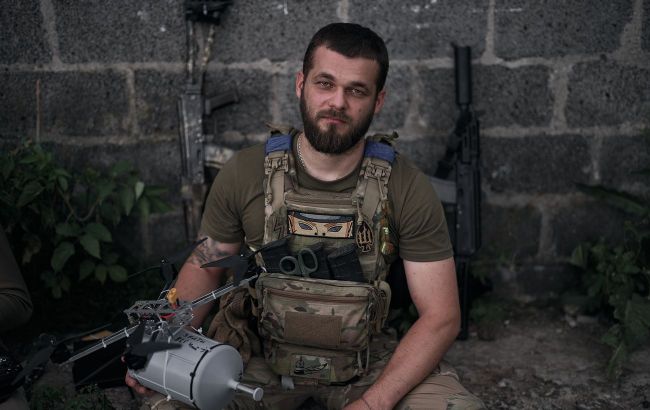Russia's fiber-optic FPV drones on rise: Ukraine's strategy to fight back
 Ukrainian soldier with a fiber optic drone (photo: Getty Images)
Ukrainian soldier with a fiber optic drone (photo: Getty Images)
The appearance of FPV drones with fiber-optic control broke away from the radio-frequency logic of modern warfare and presented new challenges for Ukraine’s Defense Forces. What are these drones, and how is Ukraine trying to counter them–read in the RBC-Ukraine's material below.
Key takeaways
-
What advantages do fiber-optic drones have over conventional FPVs?
-
What types of drones does the Russian army use, and what are their features?
-
What countermeasures are the Ukrainian Armed Forces applying?
-
How is Ukraine developing its own fiber-optic drones?
Imagine a remote-controlled toy car that moves as long as it's connected to a wire. Let go—the toy stops. Fiber-optic FPV drones work on the same principle. Instead of a radio signal, they are controlled via a thin transparent wire, similar to fishing line. And if radio can be jammed, a wire cannot. The only weakness of such a scheme is that if the cable is cut, the drone stops responding.
How fiber-optic drones appeared
At the beginning of the war, the Russians used regular FPV drones with radio control. Ukrainian soldiers quickly learned to jam their radio frequencies, and the effectiveness of enemy drones dropped. Then the Russians recalled older military technologies and decided to use wired control via fiber-optics.
"This technology was already well-developed — many people have internet at home via fiber-optics. The material base and principle of operation were long known, only technical details needed to be solved. Gradually, they developed a way to spool fiber-optic wire on reels so it could unwind easily during flight," explains Dronarium Academy instructor Dmytro Slediuk to RBC-Ukraine.
The first cases of combat use of such drones were recorded by Ukrainian troops in the Sumy region in autumn 2024. Later, they appeared along the entire front line. They are used for attacks on dugouts and equipment, flying deep into the rear for up to tens of kilometers. Additionally, to target EW systems and create an opening for conventional kamikaze drones. The Unmanned Systems Forces told RBC-Ukraine that currently, the share of fiber-optic FPV drones among the Russians is about 15–20%.

Fiber-optic drones are now used on the front much more actively than in the first months of the war (photo: Getty Images).
The 3DTech company notes that the Russian side is focused on high-reliability systems and mass production.
"The enemy has increased industrial production of such UAVs in large quantities and prioritizes the quality (reliability) of the communication line and the entire system. We monitor their solutions and work on responses — both in offensive drones and in interceptor drones," says 3DTech.
In an interview with RBC-Ukraine, Digital Transformation Minister Mykhailo Fedorov, who actively promotes drone production in Ukraine, admitted that the Russians were the first to develop a fiber-optic drone solution. And so far have scaled it better.
"We have a few projects where we need to do our homework — that's really about fiber optics and glide bombs. Until we find a way to counter them, we might face serious blows on some parts of the front," Fedorov noted.
What models are used by the Russians
The most well-known fiber-optic FPV drone is Knyaz Vandal, a mid-range strike drone designed to hit armored vehicles, strongholds, and dugouts. Its main feature is the ability to remain in standby mode for hours, essentially in a state of readiness. The drone "wakes up" only when a target appears, making it hard to detect and destroy.
Another known model is Piranha-10." This is a compact device used at shorter distances for precision attacks. Drones Skvorets and their modifications are also actively used — hybrid UAVs that can combine wired and radio control, and in some cases partially operate autonomously.
A separate niche is occupied by the Groza-Leska system — a modular solution that enables the integration of fiber-optic control into various types of drones. That is, it turns a classic FPV drone into a wired one that can bypass EW.

Piranha-10 — a drone the enemy uses at close range for pinpoint attacks (photo: Russian media)
The Unmanned Systems Forces note that the Russians are experimenting with flight ranges up to 40 km. But such models are still rare, as they require complex technical solutions and a large power reserve. The average flight altitude of these drones is 2–4 meters, and their speed is up to 40–50 km/h. Their movement is smooth and slow, which helps avoid detection.
"The enemy uses digital fiber-optic communication lines with IP cameras, installs high-powered media converters (SFP modules) designed to transmit signals over 60–80 km. Meanwhile, spools are used for 16–23 km. This gives a power reserve to compensate for potential signal attenuation during flight," explains SBS.
At the same time, Ukrainian manufacturers closely monitor the development of Russian solutions. 3DTech notes that most enemy models still rely on Chinese components.
"We see that there is still no full localization in the Russian market. Their reels, like ours, are Chinese blanks. But due to sanctions and export restrictions, many underdeveloped constructions have started to appear en masse in Russia. Drones often work unstably, especially in difficult weather," 3DTech explains.
They also add that the trend toward increasing range and autonomy in Russia will continue. "The enemy is trying to create 'scout drones' with fiber optics that can hover for an hour. We analyze their technologies and immediately adapt our countermeasures," says 3DTech.
How they fight fiber-optic drones
Electronic warfare (EW) is ineffective against fiber optics, so the main method is the physical destruction of drones. "We’ve developed a school for shooters trained to shoot down FPV drones," says the SBS.
Soldiers from brigades operating in the Kharkiv direction report that they often employ proven methods. "When a drone hovers low over the road, we cover the route with nets or wire to entangle it. Sometimes we just wait in ambush and shoot it with buckshot or shotguns," they tell RBC-Ukraine.
Some units patrol the movement routes of their equipment and try to detect drones before they activate.
An effective tactic is to cut the fiber-optic cable after the drone flies over a position. This neutralizes the FPV without a shot — just cut the cable with scissors or another tool.

When a drone hovers over a road, soldiers cover the route with nets or wire (photo: provided to RBC-Ukraine)
3DTech confirms that physically cutting the fiber-optic remains one of the simplest — though hard-to-implement — methods. At the same time, the company emphasizes the development potential of more technological solutions.
"We’re developing our own FPV interceptor drones that can detect and destroy enemy fiber-optic drones in flight. Also, we're working on turrets and automated means of detection and neutralization," says 3DTech.
According to instructor Dmytro Slediuk, the future of fiber-optic drones depends on whether effective specialized weapons against them appear. "If such weapons appear, these drones will disappear in a month. If not, the technology will likely remain for a long time, maybe forever, in one form or another," he tells the publication.
Moreover, Ukrainian troops try not only to fight drones on the battlefield but also to stop their production at the supply stage. In April and May 2025, the Armed Forces struck the Optic-Fiber Systems plant in Saransk — the only major enterprise in Russia producing fiber-optic cable for military purposes. These attacks caused significant fires and temporarily halted production.
Also in Saransk, the Saranskkabel-Optika plant was hit, and in the Rostov region—the Azov Optical-Mechanical Plant, which makes optical components for armored vehicles and drones.
How Ukraine counterattacks
So far, fiber-optic FPV drones in Ukraine haven’t reached the level of their Russian counterparts, but local companies are actively working on their development.
"We see dozens of startups trying to develop similar systems," says Slediuk.
Among the leaders is 3DTech, which already serially produces a line of Khizhak REBOFF drones. Also under development is the interceptor drone “Khizhak Shooter,” designed to destroy enemy fiber-optic FPVs.

Ukrainian manufacturers are actively working on creating fiber-optic UAVs (photo: Vitalii Nosach/RBC-Ukraine)
According to the manufacturers, such drones are effective in environments saturated with EW, where ordinary radio-controlled FPVs no longer work. They can fly under the radar horizon, remain undetected by surveillance systems, and operate in enclosed spaces, such as dugouts, buildings, and underground tunnels.
3DTech emphasizes that a fiber-optic drone is not a replacement, but rather a supplement to classic FPVs. "If the enemy has EW systems on position, the operator can first disable it with a fiber-optic drone, and then strike with radio-controlled FPVs," they say.
To support domestic production, in June 2025, President Volodymyr Zelenskyy signed two laws canceling VAT and import duties on fiber optics and other components used in drones. This should reduce the cost of critical components and stimulate local production in Ukraine.
Market participants emphasize that, besides tax relief, the state can support the industry through targeted funding programs, especially for prototype development, testing, and launching serial production. Grant programs for miltech startups, expanded state R&D, reduced bureaucracy, and infrastructure support are also necessary.
Opening international markets, according to industry representatives, will enable the scaling of production and the development of high-tech defense solutions.
***
Fiber-optic FPV drones will remain a relevant threat until systems for comprehensive detection and neutralization of such devices are created. The technology war continues: both sides are looking for ways to make their drones less vulnerable and more autonomous. The next stage will be the spread of drone swarms, group control systems, and autonomous platforms.
Sources: comments from Dronarium Academy instructor Dmytro Slediuk, the Unmanned Systems Forces, the company 3DTech, and quotes from an interview with Mykhailo Fedorov for RBC-Ukraine.

